Can a TikTok video be high art? A new musical produced entirely on TikTok has some wondering if the platform could revolutionise our culture – but others think it is just a passing craze. Around the globe, theatres stand empty, victims of the Covid-19 pandemic. But musicians are finding new ways to showcase their work online, with no pricey tickets or social distancing. On TikTok, music can go from upload to viral in a matter of hours: as long as it is only 60 seconds long. Singer Abigail Barlow and writing partner Emily Bear have found a way of using the format to their advantage, writing a full-length musical based on the wildly popular Netflix show, Bridgerton. Some have dismissed their big hit, arguing that a platform like TikTok cannot be used to create real art. But others argue that new technologies have always been fertile ground for innovative art forms. Once, all books were written by hand, mostly by monks in remote monasteries. They produced beautiful books, with elegant calligraphy and delicate illustrations. Then, in 1440, the printing press revolutionised the world of print by allowing books to be mass-produced for the first time. Traditionalists complained that it stripped books of their old beauty. Yet the printing press allowed ordinary people to start writing their own works for the first time. They wrote down ballads that had been told in their villages for generations, preserving them for posterity. And mass printing meant that people could make a living from writing. This led to the development of the novel, now regarded as one of the finest art forms of the modern era. The same happened with the invention of the camera. Previously, artists worked for years to make their paintings as realistic as possible. Then, their audiences could get a photograph for a fraction of the price. Artists complained that photos were a lesser form of art that would undermine paintings and make them obsolete. When he saw some of the earliest photographs in 1839, painter Paul Delaroche is said to have cried out: “Painting is dead!” But in reality, photography roused artists to produce new kinds of art. Since it was no longer worthwhile making paintings realistic, they experimented with more abstract forms, inventing new schools like Impressionism. And photography soon became an art form in its own right. One early movement, Pictorialism, tried to make photographs resemble paintings, with the same visual effects and emotional weight. Subsequent artists realised that they could create art from photographs by staging or finding particularly fascinating scenes. By the 1930s, photography was widely respected as art. Then in the 20th Century, television emerged as a challenge to traditional films. Culture buffs complained that the mini-series was an inferior art form. Today, TV series can win high praise from film critics. Some think that TikTok might go through the same process. Like the printing press, the camera and the TV, they claim, it will transform our understanding of art. Can a TikTok video be high art? Broken arted Yes, say some. New technology always follows the same cycle. First, traditionalists complain that a new invention is destroying art. Then, art adapts to the new technology. Finally, the technology becomes an art form itself. TikTok is the most recent example of this: the app’s users are already proving that they can make truly impressive art forms out of it. Not at all, say others. Real art requires time, effort and dedication to an original vision. TikTok favours the mass-production of short, snappy clips that copy viral trends. It is hostile territory for true creativity. Because its culture is ironic and self-aware, it produces variations on existing ideas, not original material. The TikTok musical is just another fad. KeywordsNovel - A book which tells a story.
Can a TikTok video be high art? A new musical produced entirely on TikTok has some wondering if the platform could revolutionise our culture - but others think it is just a passing craze.
Broken arted
The musical performed 60 seconds at a time

Glossary
Novel - A book which tells a story.
